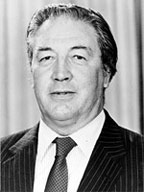John Jones
Sir John Jones was head of the British Security Service (MI5) from 1981 to 1985.[1]
Contents
Early life
Jones was born in February 1923 in Easington, Durham, the son of coalminer Isaac Jones and his wife Isabel Raine.[2] He attended Nelson Grammar School, Cumberland and won a scholarship to Christ's College Cambridge, where he arrived in 1940.[2] During the Second World War, he served as an officer in the Royal Artillery.[2] He returned to Cambridge after the war, gaining a first in part two of the historical tripos, and a certificate in education.[2]
In 1947, he entered government service in Sudan as a teacher. In 1948, he married Daphne Redman, the daughter of another official in Sudan. In 1951, he moved to the education ministry, where he became the establishment officer.[2]
MI5
Jones returned to Britain in 1955, accepting an offer to join MI5.[2] His first postings were to Hong Kong and then to Singapore from 1959 to 1961.[2]
On his return to London, he carried out the first study looking at the possibility of carrying out the computerisation of MI5 records.[3] He was then posted to MI5's overseas branch.[3]
BSSO
In 1968, Jones was seconded to the Ministry of Defence to head the British Services Security Organisation in Germany.[3] He was appointed CMG following this posting in 1972.[3]
Overseas Branch
Jones was briefly head of MI5's Overseas Branch.[3]
F Branch Chief
Jones headed MI5's F Branch from 1972 to 1974.[4] According to David Leigh, officers with a background on 'the industrial desk' such as Jones, 'David Ransome' and John Woodruffe, came to prominence in the early 1970s, because of Director Michael Hanley's prioritisation of counter-subversion.[5] Peter Wright described Jones as 'the rising star of F Branch in Hanley's new reorganization'.[6] He also recounts a counter-subversion seminar early in Hanley's tenure at which Jones was a forceful advocate for the removal of restrictions on F Branch work.[7]
According to Christopher Andrew, Jones concentrated on F Branch's counter-subversion role, paying little attention to the counter-terrorism part of its brief.[8]
In 1972, he defined subversion as "activities threatening the safety of well-being of the State and intended to undermine or overthrow Parliamentary democracy by political, industrial or violent means."[9]
Deputy Director General
Jones became Deputy Director General in 1976.[10]
Director General
Jones became Director General in 1981.[11] Peter Wright wrote of his appointment 'he was the first director-general since Hollis to have achieved it without any personal counter-espionage experience. He was an F Branch man through and through, and his appointment pefectly illustrated the shift in MI5's center of gravity.'[12]
It was early in Jones' tenure that Margaret Thatcher learned that Anthony Blunt was a Soviet spy.[3]
According to Stephen Dorril, Jones' position was weakened by the Geoffrey Prime case:
- Internally, MI5 appears to have been split between Jones's supporters, who came primarily from F Branch, and an opposition made up of the old guard of K Branch, who regarded their work as more important, and the younger officers, who had difficulty accepting the political role which the service, with its increased concentration on subversion, was expected to undertake.[13]
Hennessey and Thomas link Jones' resignation in 1985 to the Michael Bettaney case.[14]
External Resources
- Namebase: Jones John Lewis
- Tom Griffin, The boys from Berlin: The MI5 officers who covered up Kincora, Spinwatch, 12 August 2014.
Notes
- ↑ Former Directors General, MI5, accessed 30 June 2009.
- ↑ 2.0 2.1 2.2 2.3 2.4 2.5 2.6 Thomas Hennessey and Claire Thomas, Spooks: The Unofficial History of MI5, Amberley Publishing, 2009, p.571.
- ↑ 3.0 3.1 3.2 3.3 3.4 3.5 Thomas Hennessey and Claire Thomas, Spooks: The Unofficial History of MI5, Amberley Publishing, 2009, p.572.
- ↑ Christopher Andrew, Defence of the Realm, The Authorized History of MI5, Allen Lane, 2009, p.621.
- ↑ David Leigh, The Wilson Plot, Mandarin, 1989, p.209.
- ↑ Peter Wright, Spycatcher, Viking, 1987, p.359.
- ↑ Peter Wright, Spycatcher, Viking, 1987, p.360.
- ↑ Christopher Andrew, Defence of the Realm, The Authorized History of MI5, Allen Lane, 2009, p.616.
- ↑ Christopher Andrew, Defence of the Realm, The Authorized History of MI5, Allen Lane, 2009, p.591.
- ↑ Former Directors General, MI5, accessed 30 June 2009.
- ↑ Former Directors General, MI5, accessed 30 June 2009.
- ↑ Peter Wright, Spycatcher, Viking, 1987, p.359.
- ↑ Stephen Dorril, The Silent Conspiracy: Inside the Intelligence Services in the 1990s, Mandarin, 1994, p.486.
- ↑ Thomas Hennessey and Claire Thomas, Spooks: The Unofficial History of MI5, Amberley Publishing, 2009, p.574.
